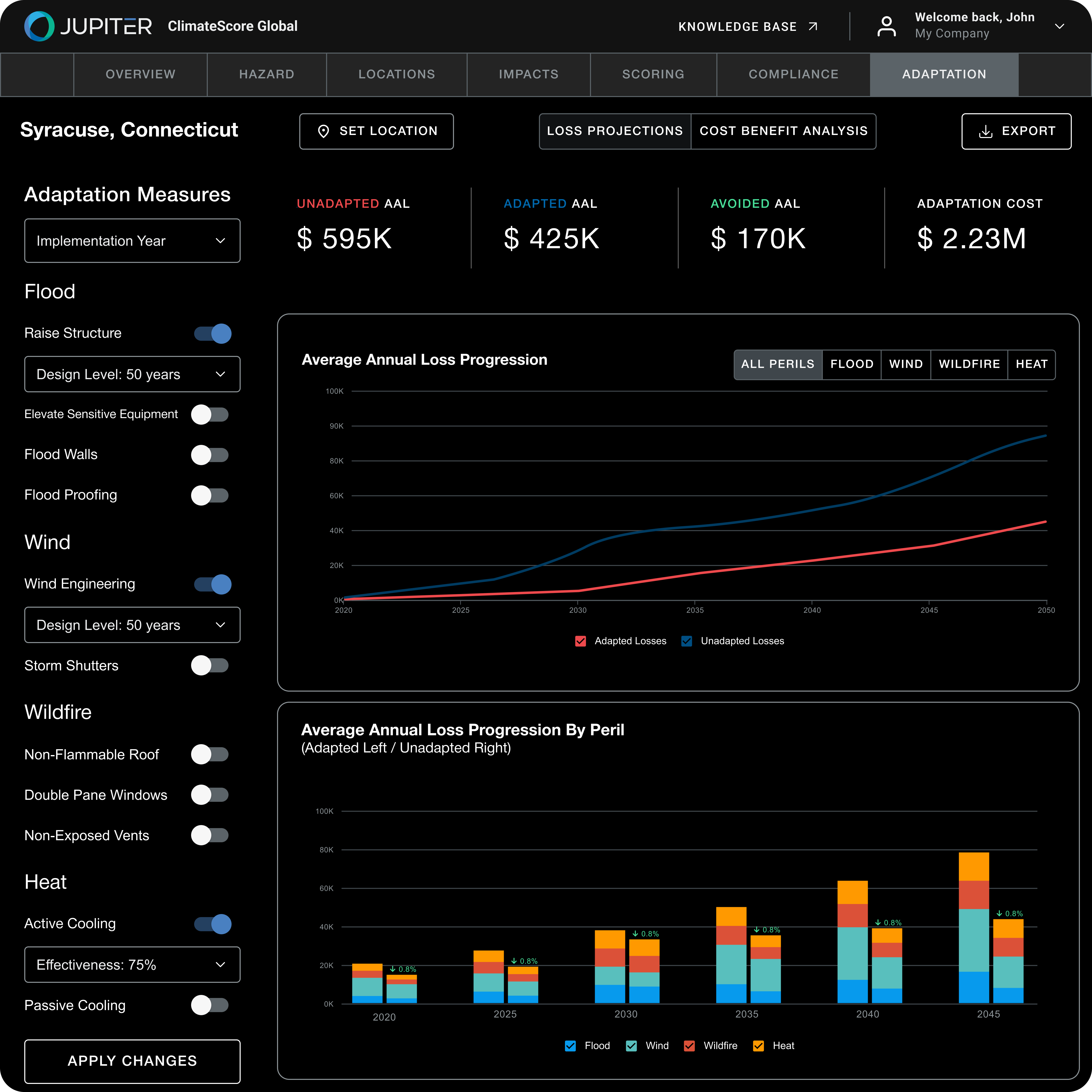
Extreme weather risk is no longer a conceptual threat. Investment teams and risk professionals already have the maps, models, and metrics showing which assets are vulnerable to flood, heat, wildfire, or wind.
But what comes next?
Traditional workflows stop at exposure. They flag vulnerable sites, check disclosure boxes, or produce ESG reports without informing actual decisions about capex, insurance, acquisitions, or loan terms. The result is a troubling gap between knowing where risk exists and knowing what to do about it.
Why Adaptation Efforts Often Stall
On paper, adaptation should be a natural next step. But in practice, even the most sophisticated firms struggle to operationalize it. Risk and ESG teams often lack the tools to simulate how specific adaptation strategies like floodwalls, AC upgrades, or wildfire retrofits affect losses, costs, or asset value. Meanwhile, investment teams need financial justification before committing capital, and consultants are too slow or expensive to keep pace with market cycles.
Across sectors, the barriers are strikingly consistent:
- No ROI visibility: It’s hard to compare adaptation options without clear, localized cost-benefit analysis.
- Fragmented data: Loss estimates, engineering assumptions, and risk projections often live in separate systems.
- Time lag: By the time a strategy is vetted externally, the deal – or the budget – may be gone.
The New Imperative: Quantify the Value of Resilience
The tide is turning. Increasingly, investment professionals want to know not just what risk exists, but how much can be avoided, and at what cost. That’s driving a new generation of tools that bring adaptation planning into the core of financial decision-making.
- In asset management, adaptation analytics enable firms to simulate strategies across their portfolios. Portfolio managers and ESG teams can quantify avoided losses, compare outcomes across scenarios, and prioritize high-ROI investments.
For example, a fund evaluating multiple industrial assets in hurricane-prone regions can now assess the benefits of retrofitting roofs, elevating mechanical systems, or adding flood defenses; and model how those interventions improve average annual loss (AAL) or long-term asset performance. These insights help reallocate capital toward more resilient holdings and strengthen LP disclosures with transparent, defendable ROI metrics.
- In private equity, the need for speed and defensibility is paramount. Adaptation modeling supports deal teams during due diligence, helping them flag uninsurable or high-risk assets early.
For assets already in the portfolio, adaptation modeling supports capex planning, identifying where targeted resilience upgrades like wildfire-safe retrofits or cooling system improvements can reduce impairment risk or justify pricing strategies. Crucially, these decisions can now be made without reliance on third-party consultants, reducing time to action and aligning better with the investment lifecycle.
- In real estate, adaptation is directly tied to value preservation. Real estate investors and REITs use adaptation modeling to evaluate site-level strategies that preserve net operating income, maintain insurability, and meet evolving tenant and board expectations.
Engineering teams can compare retrofit strategies; asset managers can benchmark resilience across holdings; and capital planning teams can justify spending on upgrades with clear, regionally adjusted ROI projections. Adaptation insights become part of everyday decision-making, not just annual reporting.
- In banking, adaptation analytics are fueling a new wave of sustainable finance. Commercial and wholesale banks are beginning to embed resilience planning into client conversations, especially when evaluating large loans for corporate borrowers. For example, a relationship manager might use adaptation modeling to show how a client could reduce risk at a high-exposure facility through targeted upgrades, and offer a supplemental loan to finance the project. This shifts risk conversations from constraint to opportunity, enabling new revenue streams while protecting the loan book.
How to Identify a Robust Adaptation Modeling Solution
Whether building an internal process for adaptation modeling, relying on external consultants, or considering physical risk software, institutions need to understand what is necessary for a robust adaptation analysis.
To evaluate whether a modeling platform is worth your investment, Jupiter recommends a 10-point checklist for adaptation analytics.

- Adaptation Attributes. Physical impacts must be modeled bottom-up, with real engineering adjustments to site-specific asset attributes, not broad assumptions like "this strategy reduces losses by 50%." Modeling should also avoid placing unrealistic demands on users, such as requiring detailed design thresholds for every asset across a large portfolio.
- Adaptation Costs. Second, cost modeling must be grounded in construction estimation best practices, with inputs sensitive to asset type, location, and scale. Construction costs should reflect geographic variation in labor and material prices, and transparently communicate uncertainty.
- Decision-Readiness. Financial metrics must align with actual decision-making frameworks: while changes in average annual loss are useful, they often fall short of what boards and investment teams require. Metrics like ROI should reflect the time value of money, distinguishing between strategies that pay back in a few years and those that take decades.
- Model Validation. And finally, all models should be validated – both internally against observed damages and externally via independent review or audit.
Whether building adaptation assessments internally, through consultants, or with software like Jupiter, these are the foundations of reliable, defensible climate resilience planning.
One Platform, Decision-Grade Insights
Adaptation planning doesn’t have to be theoretical, outsourced, or slow. With Jupiter Adaptation Hub, organizations can now simulate physical strategies, calculate avoided loss, and evaluate ROI across a range of hazards – all using the same science trusted by global financial institutions.
From modeling a flood wall at a coastal data center to evaluating AC upgrades across a REIT portfolio, Jupiter brings together:
- 10+ customizable strategies across four major hazards
- Localized cost and labor data to calculate realistic ROI
- Visual outputs that show risk reduction, portfolio impact, and financial benefit

And it all happens on the same platform already used by leaders in asset management, insurance, banking, and private equity for model risk management, entity modeling, and physical risk assessment.
Organizations no longer have to choose between speed and scientific integrity. With Jupiter Adaptation Hub, they can align resilience with how decisions really get made: in investment committees, loan desks, and capital planning cycles.
Extreme weather risk is real. But so is the value of resilience. Now, the two can be modeled in a single workflow.
Learn More
[Jupiter Webinar] From Risk to Resilience: Jupiter Adaptation Hub. See how Jupiter empowers banks, asset managers, and private equity firms to integrate climate adaptation and resilience into capital planning, portfolio strategy, and investment decisions.
[Jupiter eBook] Why Adaptation Modeling is the Next Frontier of Climate Risk Management. This is more than a guide — it’s a blueprint for embedding climate resilience into financial strategy. Learn how Jupiter’s Adaptation Hub helps you move from hazard exposure to defensible ROI with the speed and clarity capital markets demand.
[Jupiter Blog] Read how Jupiter Continues to Raise the Bar for Climate-Informed Capital Decisions
Talk with an Expert
See a demo in action or contact us here.
.webp)
